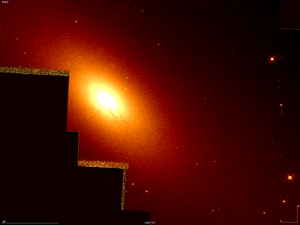NGC 5102
| Galaxy NGC 5102 |
|
|---|---|

|
|
| Photo from the Hubble Space Telescope | |
| AladinLite | |
| Constellation | centaur |
|
Position equinox : J2000.0 , epoch : J2000.0 |
|
| Right ascension | 13 h 21 m 57.6 s |
| declination | -36 ° 37 ′ 49 ″ |
| Appearance | |
| Morphological type | SA0- / HII |
| Brightness (visual) | 9.5 likes |
| Brightness (B-band) | 10.5 mag |
| Angular expansion | 8.6 ′ × 2.7 ′ |
| Position angle | 48 ° |
| Surface brightness | 13.0 mag / arcmin² |
| Physical data | |
| Affiliation | M83 group , NGC-5128 subgroup |
| Redshift | (1561 ± 7) · 10 −6 |
| Radial velocity | (468 ± 2) km / s |
|
Stroke distance v rad / H 0 |
(14 ± 1) x 10 6 ly (4.32 ± 0.32) Mpc |
| history | |
| discovery | John Herschel |
| Discovery date | April 21, 1835 |
| Catalog names | |
| NGC 5102 • PGC 46674 • ESO 382-G050 • MCG -06-29-31 • IRAS 13191-3622 • SGC 131907-3622.2 • GC 3504 • h 3492 • AM 1319-362 • HIPASS J1321-36 • LDCE 0993 NED002 | |
NGC 5102 is a lens-shaped galaxy of type E-S0 and lies in the constellation Centaur . It is estimated to be 14 million light years from the Milky Way .
The object was discovered by John Herschel on April 21, 1835 .
Recording of the 2MASS

